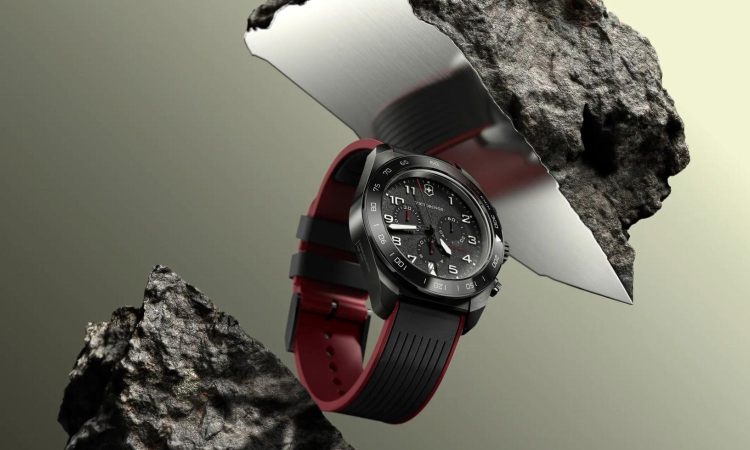DT Next Tech| Swiss watches tick louder in gen z’s analog revival
India’s smartwatch market has also fuelled this decline; shipments fell for the fifth consecutive quarter by 33% on-year in the January-March period.

Victorinox watch
CHENNAI: In the year that the Apple Watch celebrated its 10th birthday (it was launched in April 2015), the global smartwatch industry reported its first decline in annual sales numbers. We discovered an upbeat mood in Switzerland that has been the centre of fine watchmaking for centuries. Dubbed as Switzerland’s ‘Watch Valley’, the 200 km stretch between Geneva and Basel along the Jura Arc emerged as the centre of the country’s world renowned horology traditions. We travelled to Delemont that’s home to one of the newest Swiss watch brands and asked whether the Conventional watch is truly staging a comeback.
According to Research firm Counterpoint, global smartwatch shipments fell 7% YoY in 2024, the market’s first ever decline. India’s smartwatch market has also fuelled this decline; shipments fell for the fifth consecutive quarter by 33% on-year in the January-March period. Victorinox has been strongly associated with the Swiss army knife almost since it was founded in 1884. The company is one of the youngest Swiss watch brands and began its watchmaking journey in 1989. It was at the company’s Watch Competence Centre in Delemont that we saw the exacting standards that go into crafting a classic Swiss timepiece.
It's not just a stagnation of demand for smartwatches that’s seeing a resurgence of the classic watch. The Swiss watch industry is riding on quite a few favourable headwinds. The emergence of smart rings and trackers (like Whoop) that have taken the smartwatch screen out of the equation. You get all your wellness tracking (from sleep to stress and recovery) without the constant smartwatch notifications. While Swiss watch brands like Tag Heuer attempted ‘connected watches’ to take on the Apple Watch, that experiment didn’t quite challenge the smartwatch. The battle for the left wrist has become an easier fight for conventional watches with the tracker moving to the right wrist. The other big trend is the new Gen-Z fixation with all things analog. Swatch’s Moonwatch (in 2022) became a rage and scorched the sales charts.
Exports of Swiss watches to India grew nearly 30% for the first quarter of 2025, one of the most rapid increases in any major global watch market according to the Federation of the Swiss Watch Industry. Many of the team at Victorinox wear their trackers or smartwatches on the right wrist while sporting a Swiss watch on their left wrist. This reflects a global trend we’re seeing among quite a few younger consumers. The Federation of the Swiss Watch Industry stipulates that to be certified as ‘Swiss made’, a watch must meet specific criteria, including a minimum of 60% of its manufacturing costs being incurred in Switzerland. Most brands exceed this number; for instance Victorinox is 90% Swiss made.
At Victorinox’s Watch Competence Centre, we witnessed some of the stringent tests that a Swiss watch goes through to ensure the impeccable quality of the materials. This includes water-resistance testing (to 300 metres), as well as being subjected to variations in heat (5° to 70 °C) and facing up to sea water and chlorine. It’s not just the watch, the wristbands are subjected to a number of wear and tear tests that include exposure to UV rays and stretching of materials. We also watched the rotating bezels and pushers being ‘abused’ by many machines. All these preliminary checks ensure.
Our classic Swiss watch journey also took us the town of Le Chaux-de-Fonds that has been the centre of watchmaking since the 18th Century. Recognised as a UNESCO world heritage site along with the town of Le Locle, these mono-industrial towns demonstrate a fascinating symbiosis between the watch industry and urban planning. After a massive fire destroyed most of Le Chaux-de-Fonds in 1794, the entire town was built from scratch with a grid-street plan that laid emphasis on natural light – an essential for watch technicians. Some of these units continue to function to this day. Le Chaux-de-Fonds is still the watchmaking capital of the world and is home to workshops and corporate offices of brands like Omega, Rolex and Patek Phillipe.
The classic watch is certainly witnessing a comeback with nostalgia and a desire to break away from screens among some Gen Z consumers. But will fickle consumer tastes and emerging tech trends see the smartwatch back in contention? Only ‘time’ will tell.
(Ashwin Rajagopalan is a lifestyle writer and consumer technology expert. Catch the latest digital and tech updates in this weekly column.)



